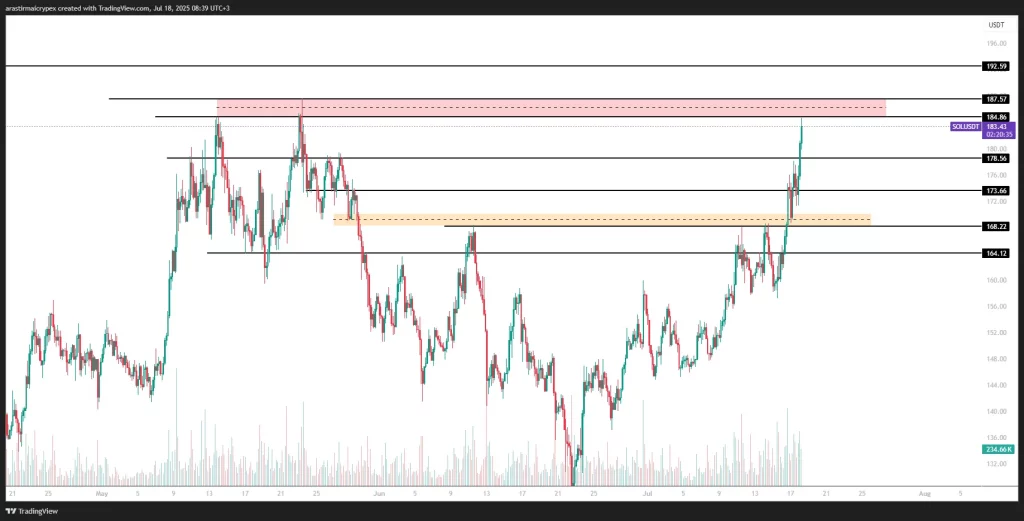US Approves Three Major Crypto Regulation Bills – XRP Reaches All-Time High
US Approves Three Major Cryptocurrency Regulation Bills
The US House of Representatives voted to approve three major cryptocurrency bills during its July session: the Digital Asset Market Clarity (CLARITY) Act, the National Stablecoin Innovations Identification (GENIUS) Act, and the Anti-CBDC Oversight Act. The CLARITY and GENIUS bills received strong bipartisan support, while the Anti-CBDC bill passed with more Republican support. These bills aim to bring clarity to the digital asset market, ensure stablecoin regulation, and offer privacy protections against central bank digital currencies (CBDCs).
While the crypto industry welcomed the legislation’s passage, some Democrats, particularly California Representative Maxine Waters, argued that these bills could pose risks to the financial system. Waters argued that Republicans were creating regulatory loopholes with these bills, endangering consumers and investors. Trump is reportedly ready to sign the GENIUS Act, while the other two bills will be debated in the Senate and then sent back to the House or the president.
XRP Reaches All-Time High
XRP reached a new all-time high in seven years, surpassing $3.50 and reaching a market capitalization of $206 billion. The asset, which rose 14% in the last 24 hours, surpassed Bitcoin last week with a 35% increase in value. This surge was driven by the US House of Representatives’ approval of crypto-friendly legislation and developments regarding Ripple’s regulated stablecoin, RLUSD. With the passage of the GENIUS Act, Ripple aims to become a pioneer in the regulated stablecoin market.
Trump Prepares to Open 401(k) Retirement Funds to Crypto and Gold
US President Donald Trump is reportedly preparing to sign an executive order that would open the $9 trillion retirement market to cryptocurrencies, gold, and private equity investments. According to sources speaking to the Financial Times, the executive order could be signed as soon as this week and could open the way for alternative investments in 401(k) plans, expanding beyond traditional stocks and bonds. This move would represent a fundamental shift in how Americans manage their savings.
The executive order will instruct Washington regulators to remove barriers to including alternative assets in professionally managed retirement funds. The Trump administration had already begun loosening crypto restrictions under the Biden administration. Trump also supports three crypto bills passed by the House of Representatives recently, and according to FT data, his family-owned company has reportedly purchased more than $2 billion worth of digital assets.
BitMine’s Ether Treasury Reaches $1 Billion
Crypto mining company BitMine rose to the top of the institutional ether treasury after rapidly increasing its Ethereum holdings, which began at the end of June, reaching 300,657 ETH. The over $1 billion in assets exceeded the $250 million the company raised through a private equity sale (PIPE). In just three days, BitMine increased its ETH holdings from $500 million to $1 billion, exceeding its PIPE proceeds by more than 300%.
This strategy signaled a shift towards ether in the corporate world, following Bitcoin-focused companies. BitMine shares, in which Peter Thiel’s Founders Fund has taken a 9.1% stake, surged nearly 27% in pre-trading sessions following the announcement. The company currently holds the title of the largest publicly traded institutional Ethereum treasury, surpassing rival SharpLink Gaming.
Ripple Co-Founder Larsen Sells $26 Million as XRP Price Nears Peak
A crypto wallet owned by Ripple co-founder Chris Larsen transferred $26 million worth of XRP to Coinbase after the price hit a seven-month high of $3.25. The transaction was the latest in a total of $344 million in XRP that Larsen has sent to centralized exchanges and utility wallets since the beginning of the year. Since such transfers are typically made for sales purposes, Larsen is believed to have liquidated his assets.
XRP has rallied 32% in the past week, approaching its all-time high of $3.40 set in 2018, while Larsen’s fortune has reached $9.7 billion. Ripple’s application for a national bank license alongside Circle, China’s Webus’s plan to establish a $300 million XRP treasury, and the prospect of an XRP ETF have all fueled investor interest, pushing the price higher. These developments have propelled XRP to the third-largest cryptoasset by market cap.
Trump Jr.-Backed Thumzup Approves $250 Million Crypto Treasury Plan
AdTech company Thumzup Media has announced, with its board of directors approving, a plan to create a $250 million digital asset treasury comprised of bitcoin, ether, XRP, Dogecoin, and other leading crypto assets. The Nasdaq-listed company’s decision coincides with the strengthening of crypto-friendly policies in the US. CEO Robert Steele said that building a diversified portfolio with a broader range of cryptocurrencies will play a key role in creating long-term value for shareholders.
Thumzup’s move came after Donald Trump Jr. invested 350,000 shares in the company, worth approximately $4 million. The company also raised $6 million in private equity last week. Thumzup, which profits from social media content sharing, reported a net loss of $2.2 million in its balance sheet in the first quarter of this year. However, the stock performance has increased by 267% since the beginning of the year.
Semler Scientific Enters the Top 15 With Bitcoin Acquisition
Semler Scientific purchased 210 Bitcoin with a $25 million investment between July 3–16, bringing its total assets to 4,846 BTC. This makes it the 14th-largest Bitcoin holding among publicly traded companies. The firm’s total BTC holdings are approximately $570 million, with an average purchase price of $93,890.
The new purchases were financed through over-the-counter (ATM) sales, which have raised $175 million since April. The company also aims to increase investor interest with its 30.3% “Bitcoin Yield” performance indicator, which reflects the increase in shares per Bitcoin. With this move, Semler has surpassed GameStop and brought crypto assets to the center of its corporate strategy.
BlackRock Files with SEC to Add Staking Feature to Ethereum ETF
BlackRock has filed a rule amendment with the SEC through Nasdaq to add staking functionality to its spot Ethereum ETF (iShares Ethereum Trust – ETHA). If approved, the fund will be able to generate returns by using its ETH holdings for validation transactions on the Ethereum network. ETHA, launched in July 2024, has become the most successful Ethereum ETF, with net inflows exceeding $7 billion to date.
Other major asset managers seeking to integrate staking into their funds include Fidelity, Grayscale, and 21Shares. The SEC is expected to rule on these requests in October. According to Bloomberg analysts, the staking feature could be approved no later than the fourth quarter of 2025. Investment interest in Ethereum ETFs continues to grow, with a total of $2.3 billion inflows into these funds over the past nine days.
Canary Capital Files for First US Staked Injective ETF
Asset manager Canary Capital has filed to launch the first US staked Injective (INJ) ETF. The Canary Staked INJ ETF will track the Injective network’s native token and also earn staking rewards. The SEC filing, following the establishment of a trust structure in Delaware, is seen as part of the growing interest in stake-based ETFs.
While staking ETFs remain under strict regulation in the US, the atmosphere has softened with President Trump’s pro-crypto administration. SEC Commissioner Hester Peirce called for public comment on whether staking programs are subject to securities laws. SEC Chairman Paul Atkins noted that most staking activities fall outside this scope. Canary has previously filed staking-based ETF applications for TRX, SEI, Cronos, and Litecoin.
Westpac and Chainlink Push for Tokenization in Australia
As part of Project Acacia, a strategic initiative of the Reserve Bank of Australia (RBA) and the Digital Finance CRC, Westpac Institutional Bank and Imperium Markets have partnered with Chainlink to develop a new blockchain-based payments infrastructure. This infrastructure enables the secure and regulatory-compliant exchange of tokenized assets via Delivery-versus-Payment (DvP) using the Chainlink Runtime Environment (CRE).
The project bridges Chainlink’s technology with the existing PayTo real-time payment system, ensuring the seamless and secure integration of both on-chain and off-chain systems. The RBA estimates that tokenization could save Australia $12 billion annually. Westpac sees the project as a significant step in realizing the potential of digital currency and blockchain infrastructure to drive innovation in wholesale markets.
France Gives Green Light to Bitcoin Mining
France plans to launch a five-year trial program to use surplus electricity from nuclear and renewable energy sources for Bitcoin mining. The bill, introduced on July 11, aims to harness this excess energy, improve grid stability, reduce volatile production at nuclear power plants, and convert it into economic value.
According to the bill, this energy can only be directed to crypto mining companies based in France or the EU. The project also includes the reuse of old industrial facilities and heat recovery. The project states that a mere 1 gigawatt allocation could generate $100–150 million in annual revenue. However, there are warnings about environmental impacts and grid integration issues.
Ondo Finance’s Tokenized Treasury Bond USDY Coming to the Sei Network
Ondo Finance, which brings real-world assets on-chain, announced the integration of its tokenized Treasury Bill product, USDY, offering a 4.25% annual yield, onto the Sei network. This will make USDY the first tokenized treasury product to launch on the ultra-fast Layer-1 blockchain, Sei. This product, aimed at individual and institutional investors outside the US, combines the liquidity of a stablecoin with the hedges of traditional finance.
Sei, whose TVL exceeded $670 million in 2025, is attracting attention with its capacity for tens of thousands of transactions per second, while the arrival of USDY makes the network attractive for institutional DeFi products. Sei Foundation executives stated that the arrival of USDY will pave the way for next-generation applications for developers. This integration strengthens both Ondo’s vision of democratizing access to institutional products and Sei’s high-throughput digital asset infrastructure.
—————————————————————————————————————
BITCOIN (BTC)
Bitcoin is trading at $120,252, gaining 1.12% as of this morning. While the price continues to test the $ 118.175 – $ 120.510 range, the $ 122.800 area above is watched as a strong resistance.
In a possible downward correction, the first support will be the $ 118.175 level, while if it declines below this level, the $ 115.896 level can be watched as an intermediate support. Further below, the $ 111.924 – $ 110.507 range is a strong support area.
If the upward momentum continues, maintaining stability above $ 120.510 may carry the price back to the $ 122.800 resistance. If this region is exceeded, prices above $124,000 may be on the agenda with new peak attempts.
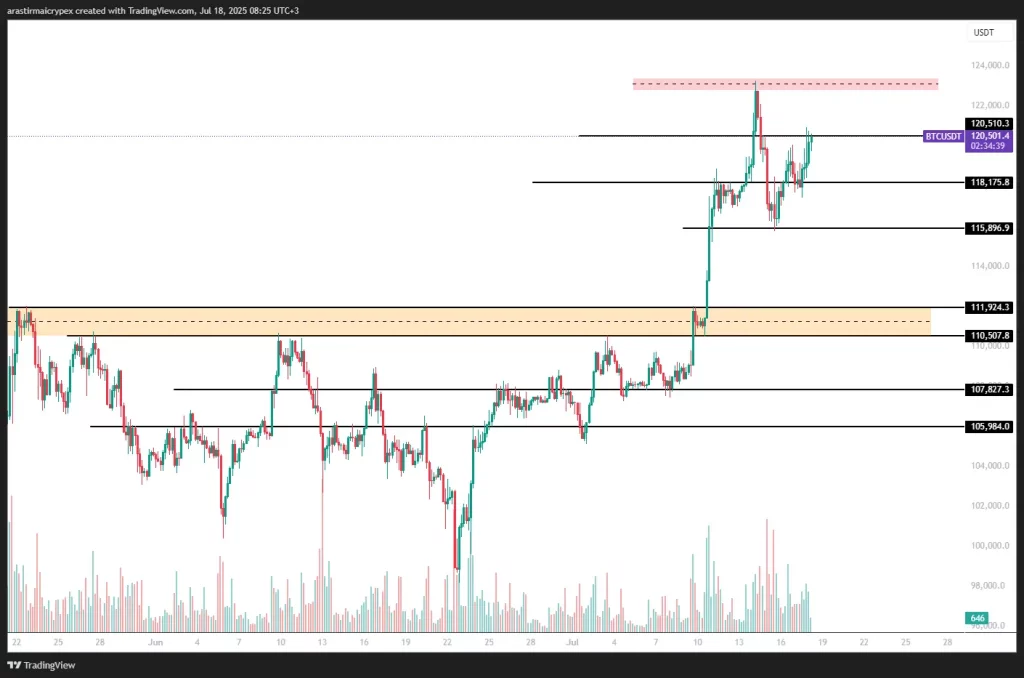
ETHEREUM (ETH)
ETH is priced at $3,638 with a 4.59% gain as of the morning hours. ETH, which has gained rapidly in value in the last two weeks, increased the upward momentum by breaking the $3,535 resistance, one of the important thresholds in psychological and technical terms.
In the continuation of this rise, the $3,746 and $4,011 levels stand out as resistance. The 3,746 region in particular should be closely monitored as it has been one of the areas that have seen intense selling pressure in the past. In case of possible pullbacks, the $ 3,535 – $ 3,434 range can be considered as a short-term support zone.
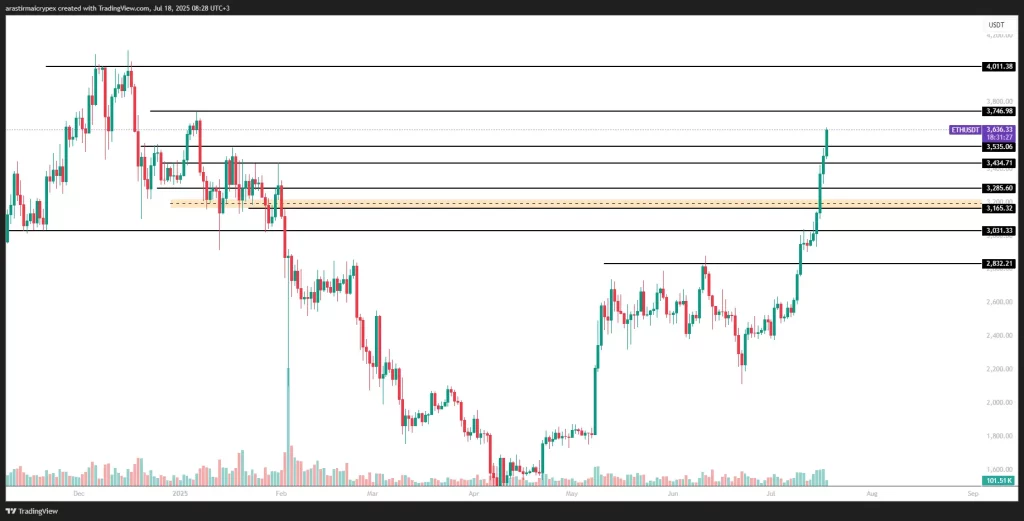
RIPPLE(XRP)
XRP rose over 4% on the last trading day of the week, reaching $3.62 and testing a new all-time high. The strong buying wave in recent weeks has easily surpassed key resistance levels, while the volume-driven rise bolsters market confidence.
If the price can hold above the new high of $3.62, price discovery could begin and upward momentum could accelerate. For potential profit realizations, the $3.48, $3.34, and $3.24 levels should be monitored as support levels, respectively. If buying appetite is maintained in these regions, the uptrend may regain momentum.
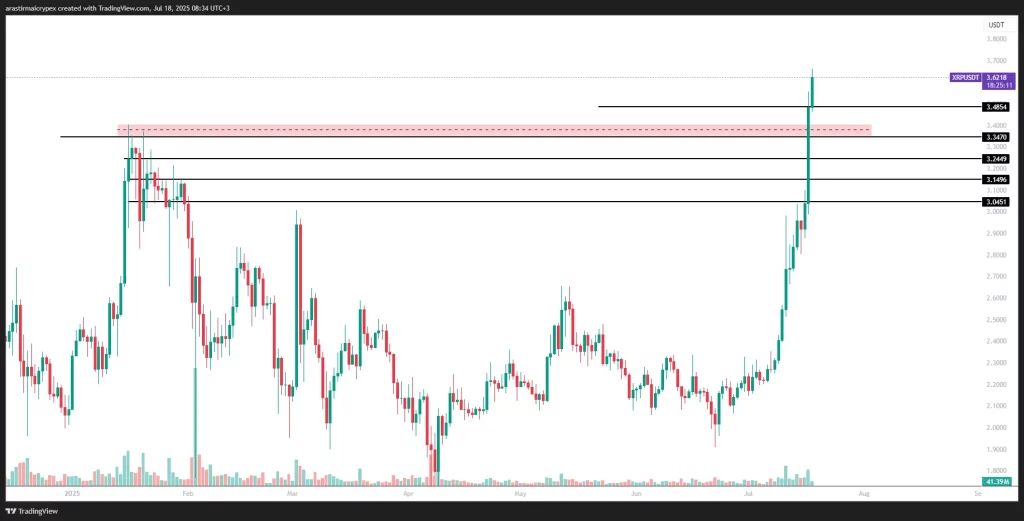
AVALANCHE(AVAX)
AVAX is traded at $ 24.75 as of the morning hours with a 3.55% gain. With this move, the critical $ 23.91 and $ 23.22 resistance levels have been broken. As the price approaches recent highs, the upward trend appears to be continuing strongly.
The $24.97 level can be monitored as a new resistance area in the short term. If this level is broken, $26.26 could be targeted. In the event of a pullback, the first support area will be the 23.91-23.22 range. As long as it stays above this zone, the upward trend can be maintained.
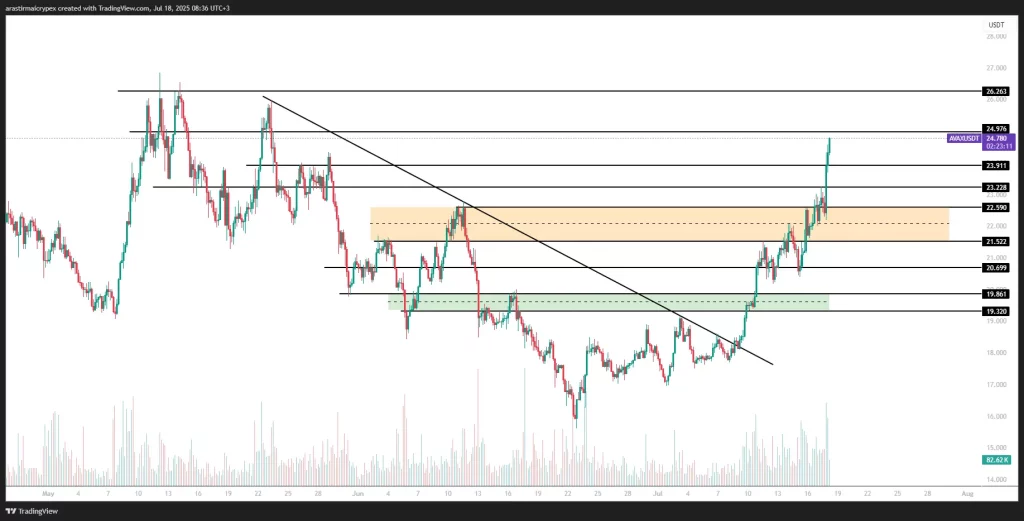
SOLANA(SOL)
SOL is traded at $183 levels with a 4.34% gain as of the morning hours. Having surpassed the resistance levels of $173.66 and $178.56 in the latest upward wave, SOL is approaching the critical $184-$187 range. This region stands out as a strong resistance area where profit-taking has occurred previously. Maintaining stability above $187.50 is crucial for the continuation of the rise. In this case, the price may accelerate towards $192.50.
The $178.50 and $173.60 levels will be monitored as initial support levels for potential profit-taking. Protecting these areas will be critical for the continuation of the upward momentum in the short term.
